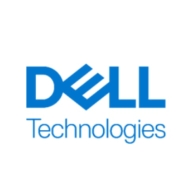


IBM FlashSystem and Dell PowerStore are two leading enterprise storage solutions. Dell PowerStore appears to have the upper hand due to its scalability and advanced features.
Features: IBM FlashSystem's valuable features include exceptional integration capabilities, robust performance, and ease of setup. Dell PowerStore stands out with its scalability, automation, and advanced user-friendly features.
Room for Improvement: Users suggest IBM FlashSystem could enhance its documentation, customer training, and user support. Dell PowerStore users point to a need for more detailed error reporting, advanced analytics, and deeper insights.
Ease of Deployment and Customer Service: IBM FlashSystem is favored for its straightforward deployment and responsive customer service. Dell PowerStore is noted for its efficient deployment process and thorough customer support. Both products perform well, but Dell PowerStore edges out with its supportive infrastructure.
Pricing and ROI: IBM FlashSystem is viewed as cost-efficient with a good ROI and lower setup costs. Dell PowerStore, although generally more expensive, offers superior features and long-term value, making it worth the investment.
If you wait more than seven years to buy another one, you get a return on your investment.
If you purchase storage with 300 terabytes, you can easily achieve one petabyte of effective capacity.
It's been trouble-free the entire time, with very high performance, as it has been designed and built properly.
We have seen a return on our investment in Dell PowerStore; definitely our cost per terabyte has been very good compared to some of the other vendors that we would have been using previously, and our performance benchmarks have exceeded what we were expecting.
The solution can comfortably be stretched from five to seven years without any failures, ensuring a long-lasting return.
We have seen return on investment compared to other OEMs, which took approximately three years after implementing IBM FlashSystem.
Customers always have their issues resolved promptly.
Technical support is good at least through vendors, not directly with the principal.
I would rate the technical support of Dell PowerStore between nine and ten out of ten.
They're responsive, knowledgeable, and have a quick turnaround.
On a scale of one to ten, I would rate Dell support as a ten, focusing on that aspect alone, because it's what allows me to sleep at night.
Customers of alternatives like Dell and Hitachi enjoy more reliable and comprehensive support services directly from vendors rather than third-party subsidiaries.
I rate the technical support from IBM as a ten.
IBM customer support is responsible, efficient, and responsive, though it is expensive.
It hasn't broken down anytime in the last six to seven years, despite hurricanes, earthquakes, and power outages.
The solution's scalability is a ten out of ten.
It scales up and scales out both ways, and as our data keeps growing, it is very easy to just keep attaching and keep growing.
Scaling up can be done from a single enclosure that already has two controllers to a maximum of four storage units with up to eight controllers, and a massive amount of storage can be added.
For larger enterprises, scalability is an issue as the price becomes prohibitive.
The problem arises when migrating data to a later IBM FlashSystem version due to issues with firmware compatibility.
The scalability of IBM FlashSystem is exceptional, and I rate it as a nine.
I would rate the stability of the product at seven out of ten.
When I removed all the cables, it failed over within five minutes.
It's quite stable and reliable in general.
There are no bugs or glitches and it doesn't crash or freeze.
Customers have infrastructure that is 100% stable.
The firmware and software engine have fewer bugs, which enhances operational efficiency.
One way to improve the product is to add an operational assistant that doesn't depend on VMware.
I would like to see some AI features that would allow arrays to intelligently identify threats or unusual behavior in the data pattern and give an alert.
Storage replication should be essential.
Something needs to be done with the caching to ensure that if some issue occurs, there needs to be an ability to disable caching during maintenance to make it static, safe, and good.
Pricing must also be considered, as Dell PowerStore is quite expensive compared to competitors in the market like HPE Alletra, Huawei Dorado, or Hitachi storage, for example.
The main reason why people move to Pure Storage is because it's simplified.
Despite marketing promises, these features do not function effectively and can impact performance.
There is room for improvement in the troubleshooting part, specifically related to IBM Spectrum for Insight.
An additional function that could be helpful is reducing the time it takes to delete volumes, especially if they are compressed or deduplicated.
While the prices may be higher than those of other vendors, we see it as a market leader with benefits.
The support can be a bit pricey, but the solution is more cost-effective than anything else out there.
Likely the cost is $400,000 whereas IBM may be $250,000.
Based on my experience, the cost of Dell PowerStore for around 500 GB of capacity is very competitive compared to any other platform in the market.
I asked for a new quotation on a server, and it is quite expensive; it is really expensive.
To install or upgrade any software features, the cost is high, which makes it challenging for smaller companies who do not require advanced features like deduplication or compression typically needed by larger organizations.
The pricing is high; storage solutions are always expensive.
Its data compression feature is the best that we have ever seen.
Pure FlashArray X NVMe helps to improve our processing speed.
We are satisfied with the performance as it is significantly faster compared to traditional storage options.
This includes storage sharing, adding servers to the service, and the wireless host connection on the network side.
Dell PowerStore offers good integration capabilities, especially since it helps with backup, which is an important aspect.
In terms of whether my company could reduce the power consumption with Dell PowerStore, I would say that my company had a use case with a customer around three weeks ago where their old Dell EMC VNX Storage System used to draw about 2500 watts compared to Dell PowerStore which drew about 800 watts, which is a really a big saving looking at the twenty-four hours and seven days of usage of the system.
There is a significant amount of data reduction, achieving a ratio of one to three.
The most valuable features are performance and reliability.
There is built-in compression, a data reduction feature, and artificial intelligence-driven insights that calculate warnings and errors to redirect to customers automatically.


| Company Size | Count |
|---|---|
| Small Business | 15 |
| Midsize Enterprise | 11 |
| Large Enterprise | 12 |
| Company Size | Count |
|---|---|
| Small Business | 49 |
| Midsize Enterprise | 33 |
| Large Enterprise | 74 |
| Company Size | Count |
|---|---|
| Small Business | 47 |
| Midsize Enterprise | 21 |
| Large Enterprise | 59 |
Pure Storage FlashArray//X is the world’s first enterprise-class, all-NVMe flash storage array. It represents a new class of storage – shared accelerated storage, which is a term coined by Gartner – that delivers major breakthroughs in performance, simplicity, and consolidation.
Dell PowerStore is a scalable, high-performance platform supporting both modern and traditional workloads, enhancing IT operations with AI-driven automation and advanced data reduction features.
Designed for flexibility, Dell PowerStore integrates seamlessly with VMware, providing robust security and high IOPS. Users benefit from fast NVMe storage, intelligent data management, and scalable performance to handle diverse workload demands. However, improvements are needed in replication, enterprise functionalities, and UI complexity. Stability and support issues highlight the need for enhanced monitoring and pricing strategies.
What are the key features of Dell PowerStore?
What benefits does Dell PowerStore offer?
In industries like finance, healthcare, and IT, Dell PowerStore is critical for VMware virtualization, high-performance databases, and backup storage. It supports hosting virtual machines, mirroring storage, and handling SAP and Oracle databases effectively. Its role in hybrid and on-premises setups showcases its adaptability and integration capabilities for mission-critical tasks.
IBM FlashSystem products are enterprise computer data storage systems that store data on flash memory chips. Unlike storage systems that use standard solid-state drives, IBM FlashSystem products incorporate custom hardware based on technology from the 2012 acquisition of Texas Memory Systems. This hardware provides performance, reliability, and efficiency benefits versus competitive offerings.
We monitor all NAS reviews to prevent fraudulent reviews and keep review quality high. We do not post reviews by company employees or direct competitors. We validate each review for authenticity via cross-reference with LinkedIn, and personal follow-up with the reviewer when necessary.